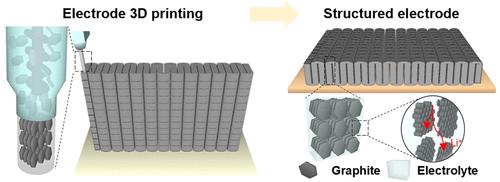当前位置:
X-MOL 学术
›
Nano Lett.
›
论文详情
Our official English website, www.x-mol.net, welcomes your
feedback! (Note: you will need to create a separate account there.)
Structured Electrode Additive Manufacturing for Lithium-Ion Batteries
Nano Letters ( IF 9.6 ) Pub Date : 2022-11-18 , DOI: 10.1021/acs.nanolett.2c03545 Soyeon Park 1 , Baohui Shi 1 , Yuanyuan Shang 1 , Kaiyue Deng 1 , Kun Fu 1, 2
Nano Letters ( IF 9.6 ) Pub Date : 2022-11-18 , DOI: 10.1021/acs.nanolett.2c03545 Soyeon Park 1 , Baohui Shi 1 , Yuanyuan Shang 1 , Kaiyue Deng 1 , Kun Fu 1, 2
Affiliation

|
As the world increasingly swaps fossil fuels, significant advances in lithium-ion batteries have occurred over the past decade. Though demand for increased energy density with mechanical stability continues to be strong, attempts to use traditional ink-casting to increase electrode thickness or geometric complexity have had limited success. Here, we combined a nanomaterial orientation with 3D printing and developed a dry electrode processing route, structured electrode additive manufacturing (SEAM), to rapidly fabricate thick electrodes with an out-of-plane aligned architecture with low tortuosity and mechanical robustness. SEAM uses a shear flow of molten feedstock to control the orientation of the anisotropic materials across nano to macro scales, favoring Li-ion transport and insertion. These structured electrodes with 1 mm thickness have more than twice the specific capacity at 1 C compared to slurry-cast electrodes and have higher mechanical properties (compressive strength of 0.84 MPa and modulus of 5 MPa) than other reported 3D-printed electrodes.
中文翻译:

用于锂离子电池的结构化电极增材制造
随着世界越来越多地交换化石燃料,锂离子电池在过去十年中取得了重大进展。尽管对增加能量密度和机械稳定性的需求持续强劲,但使用传统油墨浇铸来增加电极厚度或几何复杂性的尝试取得的成功有限。在这里,我们将纳米材料取向与 3D 打印相结合,并开发了一种干电极加工路线,即结构化电极增材制造 (SEAM),以快速制造具有低曲折度和机械鲁棒性的平面外对齐结构的厚电极。SEAM 使用熔融原料的剪切流来控制纳米到宏观尺度的各向异性材料的方向,有利于锂离子传输和插入。
更新日期:2022-11-18
中文翻译:

用于锂离子电池的结构化电极增材制造
随着世界越来越多地交换化石燃料,锂离子电池在过去十年中取得了重大进展。尽管对增加能量密度和机械稳定性的需求持续强劲,但使用传统油墨浇铸来增加电极厚度或几何复杂性的尝试取得的成功有限。在这里,我们将纳米材料取向与 3D 打印相结合,并开发了一种干电极加工路线,即结构化电极增材制造 (SEAM),以快速制造具有低曲折度和机械鲁棒性的平面外对齐结构的厚电极。SEAM 使用熔融原料的剪切流来控制纳米到宏观尺度的各向异性材料的方向,有利于锂离子传输和插入。











































 京公网安备 11010802027423号
京公网安备 11010802027423号